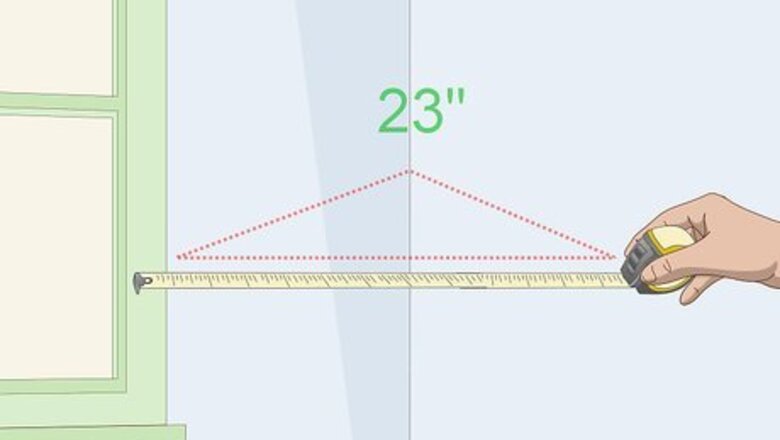
views
Building Triangle Corner Shelves
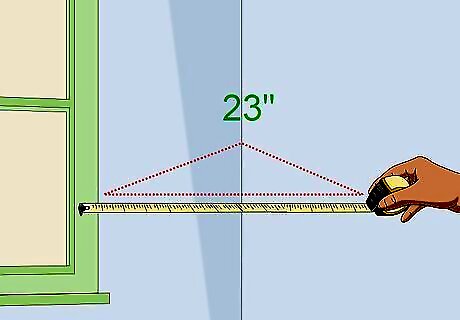
Measure the desired length of your shelves. Measure the two walls where the corner shelves will fit with a tape measure. Keep in mind that you'll want both of your shelves to be the same size on each wall. For the purpose of this shelf, we'll be creating a shelf with a 23-inch (58.42 cm) face. Measure from the corner of the wall to the space where you want your bookshelf to hang.
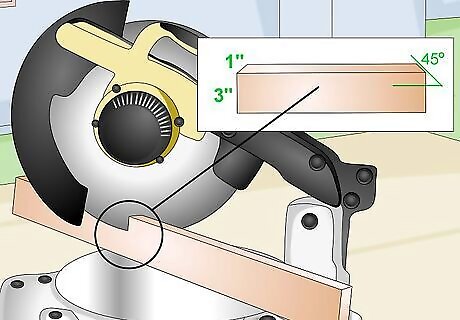
Cut two 45 degree angles on a 1x3 inch (2.54x7.62 cm) board. Lay your board on the thin edge. On one end of a 1x3 inch (2.54x7.62 cm) board cut a 45-degree angle with a miter saw. Once you've made one cut, measure 23 inches (58.42 cm) down the board and mark an X. Cut another 45-degree angle, pointing outward, on the end of your board at the X that you drew. This piece of wood will become the face of your shelf. Each end of your 1x3 inch (2.54x7.62 cm) board should be cut at a 45 degree angle. Read the instruction manual for your miter saw and remember to keep your hands away from the blade. Wear goggles and a face mask when cutting wood. This board will act as a pattern that will help you build the rest of your shelves.
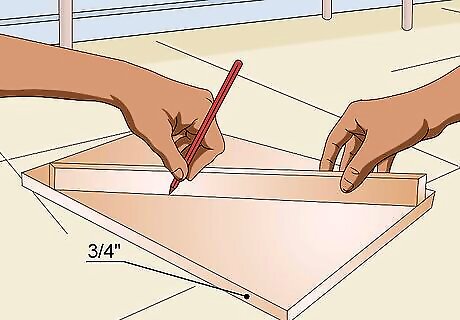
Lay your measuring piece on top of a 3/4 inch (1.9 cm) thick plywood. Lay the 1x3 inch (2.54x7.62 cm) measuring wood diagonally on the surface of a piece of plywood. Flush the edges of your board to each side of the plywood. This should look like you are laying the wooden board over the corner of the plywood and creating a triangle. Draw a line straight across the plywood, using the board as your stencil. This will create what will be the top shelf.
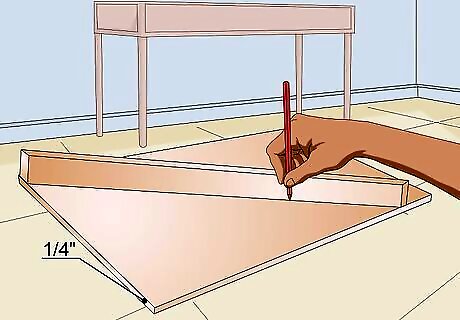
Measure the bottom of the shelf on a 1/4-inch (0.63 cm) plywood. Repeat the process that you just did, but this time on a thinner, 1/4-inch (0.63 cm), piece of plywood. Lay the 1x3 inch (2.54x7.62 cm) board that you cut previously over this piece of plywood and use a pencil to draw a straight line to create a triangle. This piece of wood will act as the bottom of your shelf.
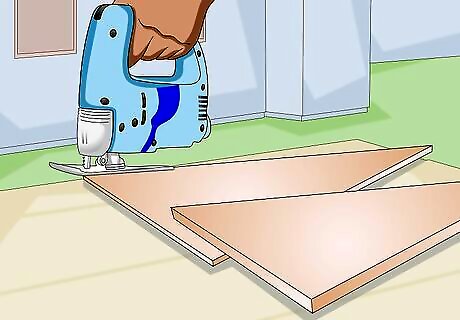
Make straight cuts through the lines you drew on the plywood. Cut each piece of your plywood with a circular saw. Each of these pieces of plywood should be equal in size because you used the same piece of 1x3 inch (2.54x7.62 cm) board as a stencil to draw your cutting line.
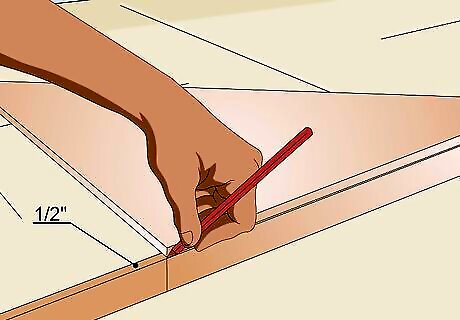
Lay your triangle over the top of a 1x2-inch (2.54x 5.08 cm) board of wood. Lay the triangle piece that you created with plywood over the piece of 1x2-inch (2.54x 5.08 cm) wood that's laid out on its thin edge. Use a pencil to outline the triangle and make two diagonal lines on both ends of your 1x2-inch (2.54x 5.08 cm) wooden board. Marking this line with a pencil will create lines for your cuts. Doing this will give you the exact dimensions of your frame without having to re-measure.
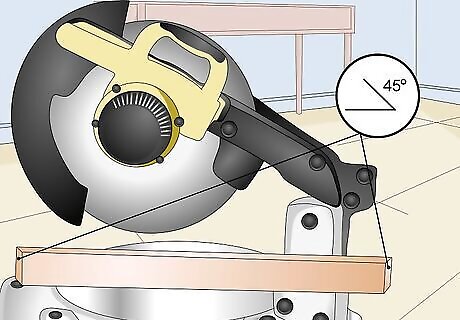
Cut the lines that you created. Cut the 45-degree angles to create the frame for your shelves on the 1x2-inch (2.54x 5.08 cm) piece of wood. This piece of wood will be the front of your frame.
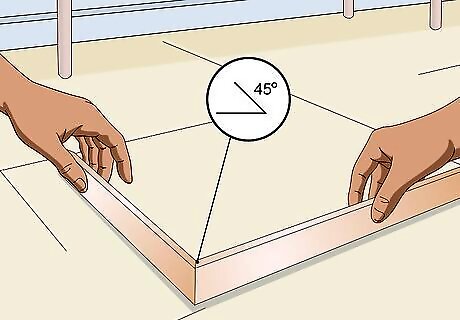
Line up the two boards to create the tip of the frame. Take the excess board that you cut away from your 1x2-inch (2.54x 5.08 cm) board and line it up on the 45-degree angle of your freshly cut board. The boards should fit together flush on a the 45 degree angle that you cut. It should look like two sides of a triangle.
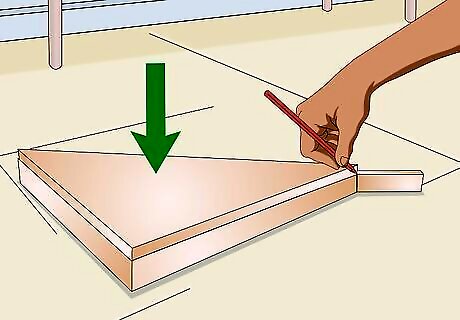
Position your plywood triangle over the frame. Lay the plywood triangle over the 1x2-inch (2.54x 5.08 cm) piece of wood and use it to create another line on the excess piece that you just created. This piece should be longer than your other piece, and the excess will need to be removed. Draw a straight line where the plywood meets the wood, so that top of the shelf will run flush with your frame.
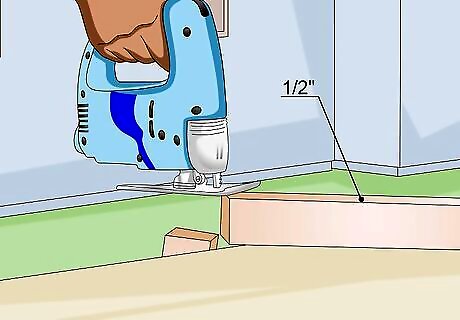
Cut the last piece of wood to create the last piece of your frame. Using the circular saw again, cut the line that you just created on the 1x2-inch (2.54x 5.08 cm) piece of excess wood. This cut will be a straight line, at the bottom of the triangle, rather than a 45-degree angle.
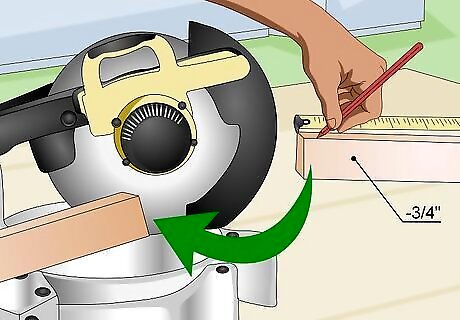
Cut the last piece of your frame. To get the proper length of the last piece of your frame, line up all three of the pieces of 1x2-inch (2.54x 5.08 cm) board. Lay your plywood over the frame again and make a mark on the last piece of 1x2-inch (2.54x 5.08 cm) wood, using the plywood as a stencil. Take a tape measure, and measure 3/4 of an inch (1.905 cm) in from that mark and draw a straight line across to make the final piece of the frame shorter. Cutting the last part of the frame 3/4 of an inch (1.905 cm) shorter will allow all pieces of your frame to line up.
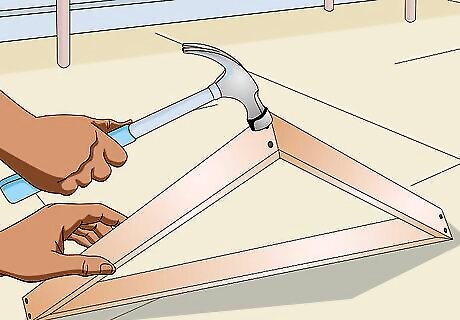
Assemble your frame. Line up the three sides of your frame and drive nails into all three corners of the frame. The nail should be driven through two sides of the triangle each time. Make sure that the nails connect each piece of the wooden frame together, securely.
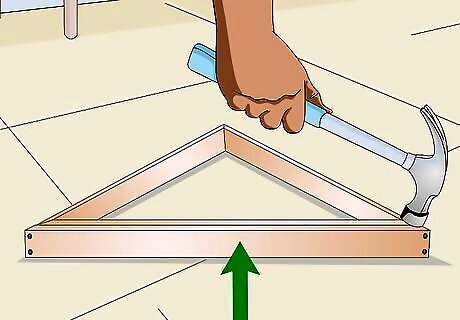
Nail or staple the front of the shelf to the frame. Use the original 1x3 inch (2.54x7.62 cm) piece of wood that you used for a stencil to fit over the front of your corner shelf. Use nails or screws on each side of the faceplate to secure it to the rest of your frame made up of 1x2-inch (2.54x 5.08 cm) pieces of wood .
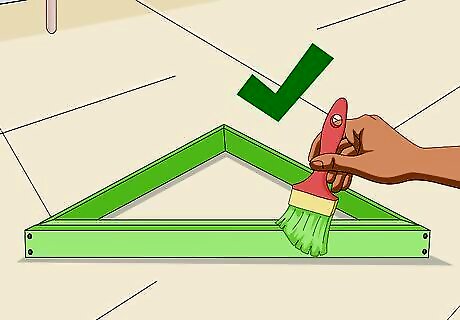
Paint or decorate your corner shelf. You can choose to keep your corner shelf the color of the wood that you created it with, or you can paint or stain your corner shelf. If you plan on placing things that can create moisture on your shelves, make sure to seal it to prevent damage to the paint.
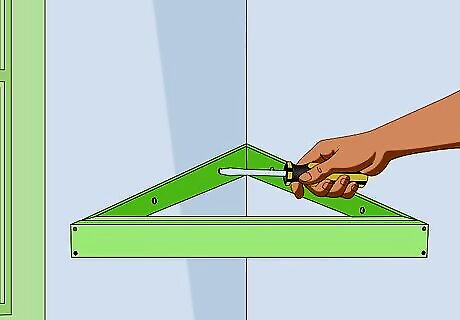
Nail or screw your corner shelf into the wall. Line the frame with your corner shelf into the corner of the room. Use nails and drive the parts of the frame that are touching the wall into your wall. You may need to put multiple nails into your frame depending on how much weight you want your corner shelf to be able to support. If there are studs near the corner of your wall, drive the nails into them instead of the sheetrock. Use wall anchors and screws to better support your corner shelf if you are using more weight.
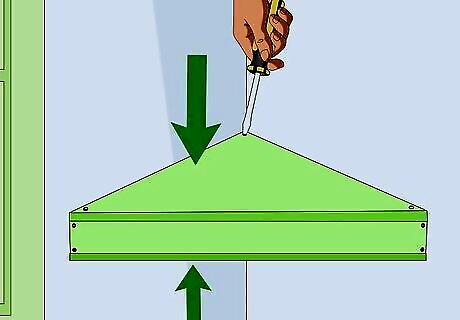
Nail or staple the top and bottom of the shelf to the frame. Take the triangular pieces of plywood that you cut previously and set the thicker piece on top of the shelf. Drive nails or screws into the surface of the plywood and into your wooden frame to secure the top of the corner shelf to the frame. Your project is now complete and you can use your corner shelves to store things.
Building a Corner Ladder Bookshelf
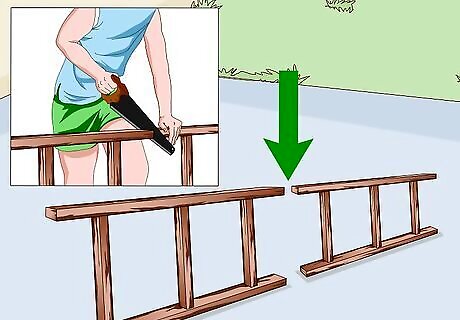
Cut a wooden ladder in half. Use a hand saw or circular saw to cut a wooden ladder in half, width-wise, so that you have two halves of a ladder with complete rungs. Each half of the ladder will act as a shelf on both walls and will create a corner shelf.
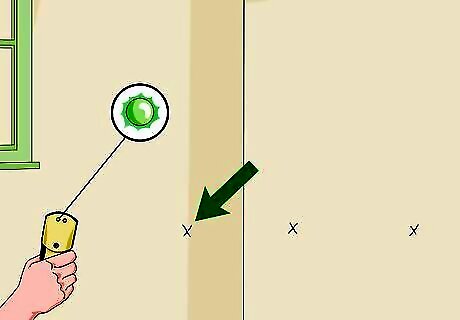
Use a stud finder to find the studs in your wall. Use an electronic stud finder that you can purchase at most home improvement stores. Slowly go over your wall with the stud finder until the indicator light flashes, indicating the presence of a stud. Find two studs on each of the walls and draw an X. When you are done, you should have four Xs. You'll use the studs to anchor your L brackets.
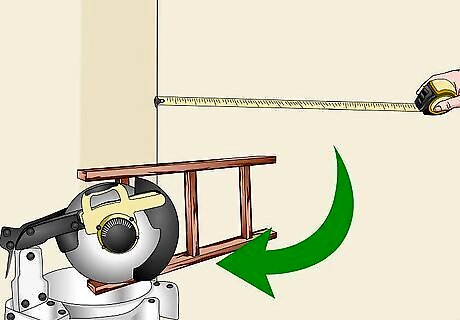
Measure your walls and cut your ladder to length. Use a measuring tape to determine the width of each of the walls that you want your ladder bookshelf to be on. If your walls are smaller than the length of the ladder, you'll have to cut down each half to accommodate the size of your walls. Use a circular saw to cut down the ladder again to the measurements that you recorded.
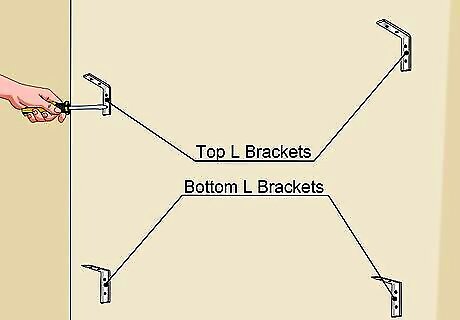
Screw L brackets into the wall to support the ladder. Use screws to screw in the L bracket firmly where you marked the studs. This bracket will be where the bottom of the ladder rests. Use a tape measure to gauge the height of your ladder. Once you get the ladder's height, use a tape measure to draw another X on each of the studs that correspond with the height of the ladder. This will designate where the top L brackets should be screwed in. Once you've screwed in all of your L brackets you should have a total of 4 L brackets on each wall. Screw in the top L bracket so that the ladder hangs over the L bracket. Screw in the bottom L bracket so that the ladder rests on top of it.
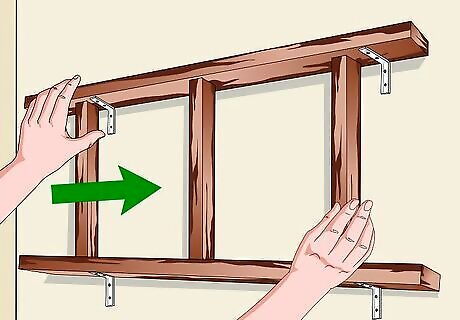
Mount your ladder to the L brackets. Lift one-half of your ladder and place it onto your L brackets. Make sure that the brackets line up with the top and bottom of your ladder. After you mount your ladder to the bottom L brackets, you can work on securing the ladder to the brackets themselves.
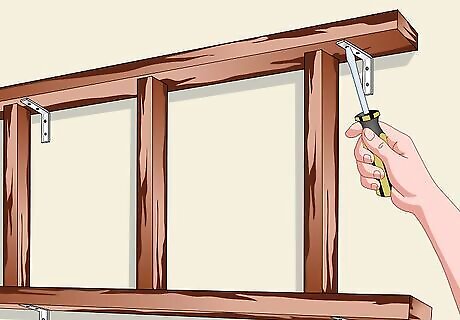
Screw your ladder into the L brackets. Use screws to screw the wooden ladder to the metal L-brackets on the wall. Use a power drill to drive the screws halfway into the holes of the L brackets and into your wooden ladder. Once all the L brackets have been screwed in half way, use your power drill to tighten the screws and secure the ladder to the wall.
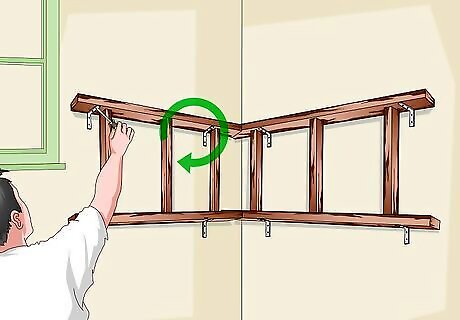
Repeat the process with the other half of your ladder. Hang and drill the other side of the ladder to the other wall in your room. Once you're done securing it to the wall, you'll have completed creating a corner shelf using a wooden ladder.
















Comments
0 comment